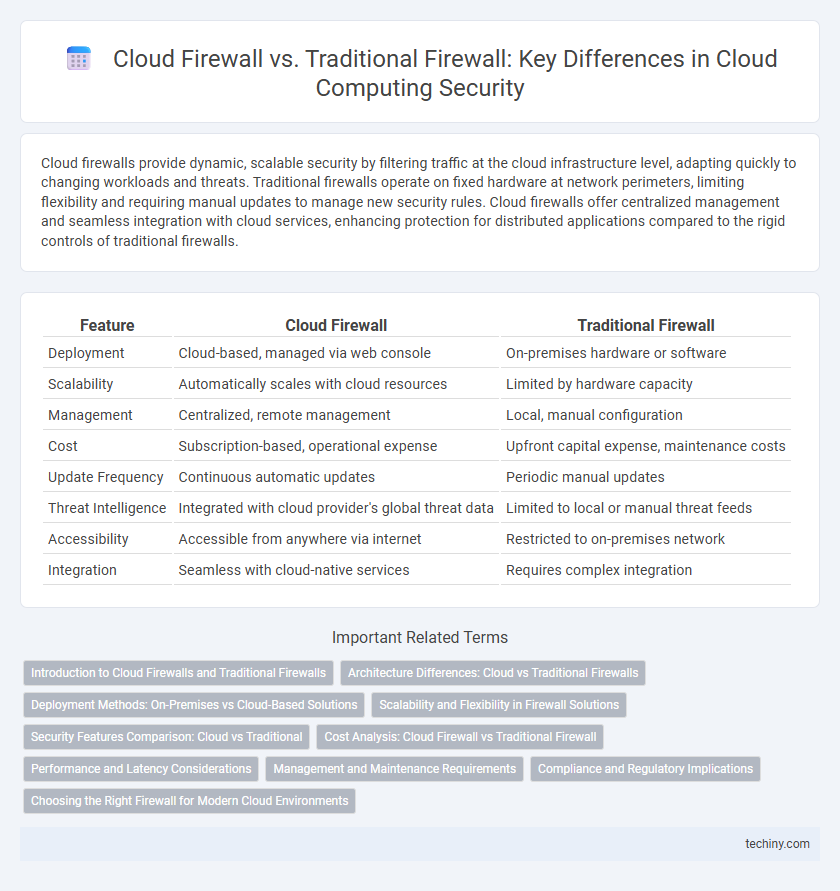Cloud firewalls provide dynamic, scalable security by filtering traffic at the cloud infrastructure level, adapting quickly to changing workloads and threats. Traditional firewalls operate on fixed hardware at network perimeters, limiting flexibility and requiring manual updates to manage new security rules. Cloud firewalls offer centralized management and seamless integration with cloud services, enhancing protection for distributed applications compared to the rigid controls of traditional firewalls.
Table of Comparison
| Feature | Cloud Firewall | Traditional Firewall |
|---|---|---|
| Deployment | Cloud-based, managed via web console | On-premises hardware or software |
| Scalability | Automatically scales with cloud resources | Limited by hardware capacity |
| Management | Centralized, remote management | Local, manual configuration |
| Cost | Subscription-based, operational expense | Upfront capital expense, maintenance costs |
| Update Frequency | Continuous automatic updates | Periodic manual updates |
| Threat Intelligence | Integrated with cloud provider's global threat data | Limited to local or manual threat feeds |
| Accessibility | Accessible from anywhere via internet | Restricted to on-premises network |
| Integration | Seamless with cloud-native services | Requires complex integration |
Introduction to Cloud Firewalls and Traditional Firewalls
Cloud firewalls, designed for dynamic cloud environments, offer scalable, automated security by filtering traffic at the cloud infrastructure level, integrating directly with cloud service platforms like AWS, Azure, and Google Cloud. Traditional firewalls operate as hardware or software appliances at network perimeters, primarily protecting on-premises data centers by monitoring incoming and outgoing network traffic based on predefined security rules. The shift from traditional to cloud firewalls reflects a need for enhanced agility, real-time threat detection, and centralized management in modern, distributed IT architectures.
Architecture Differences: Cloud vs Traditional Firewalls
Cloud firewalls leverage distributed architectures integrated with cloud service providers, offering scalable, centralized management across dynamic virtual environments. Traditional firewalls rely on hardware-based, perimeter-focused models that protect fixed networks with limited scalability and manual configuration. Cloud firewalls provide real-time policy enforcement and automated updates aligned with elastic workloads, contrasting the static rule sets of traditional firewall appliances.
Deployment Methods: On-Premises vs Cloud-Based Solutions
Cloud firewall deployment typically involves cloud-based solutions that offer scalable, centralized management and seamless integration with cloud environments, contrasting with traditional firewalls which are deployed on-premises and require dedicated hardware maintenance. On-premises firewalls provide direct control and low-latency security enforcement but lack the flexibility and rapid scalability inherent in cloud firewalls. Cloud-based firewalls leverage distributed infrastructure to enable dynamic updates and threat intelligence sharing, enhancing protection against evolving cyber threats across hybrid and multi-cloud architectures.
Scalability and Flexibility in Firewall Solutions
Cloud firewalls offer superior scalability by dynamically adjusting to varying network traffic and workload demands without requiring physical hardware changes. Unlike traditional firewalls, cloud firewall solutions provide enhanced flexibility through centralized management and seamless integration with cloud-native services across multiple environments. This elasticity enables organizations to efficiently protect expanding infrastructures while minimizing manual configuration and deployment delays.
Security Features Comparison: Cloud vs Traditional
Cloud firewalls offer dynamic scalability and real-time threat intelligence integration, enabling immediate adaptation to emerging cyber threats compared to traditional firewalls that rely on static rule sets. Cloud firewalls provide granular visibility into East-West traffic across distributed environments, while traditional firewalls primarily monitor North-South traffic at network perimeters. Advanced features like AI-driven anomaly detection and automated policy enforcement are inherent in cloud firewall solutions, surpassing the manual configuration and limited automation found in traditional firewall systems.
Cost Analysis: Cloud Firewall vs Traditional Firewall
Cloud firewalls typically reduce overall costs by eliminating the need for expensive hardware, maintenance, and manual updates associated with traditional firewalls. Pay-as-you-go pricing models and scalability in cloud firewalls further optimize expenses by aligning costs with actual usage and demand. Traditional firewalls often incur higher upfront investments and ongoing operational expenses, making cloud firewalls more cost-effective for dynamic and growing network environments.
Performance and Latency Considerations
Cloud firewalls optimize performance by leveraging distributed network architectures, reducing latency through proximity to end-users and scalable resource allocation. Traditional firewalls often introduce higher latency due to centralized hardware processing and limited scalability under peak loads. Cloud firewalls support dynamic traffic patterns with elastic bandwidth, ensuring minimal performance degradation compared to rigid traditional firewall systems.
Management and Maintenance Requirements
Cloud firewalls require less management and maintenance compared to traditional firewalls due to automated updates and centralized control within cloud platforms. Traditional firewalls demand manual configuration, frequent patching, and physical hardware management, increasing operational overhead. Cloud firewall solutions offer scalability and simplified rule enforcement, reducing the need for constant administrative intervention.
Compliance and Regulatory Implications
Cloud firewalls offer enhanced compliance with dynamic regulatory frameworks by providing real-time monitoring, automated updates, and granular visibility across distributed environments. Traditional firewalls often struggle to meet evolving compliance standards due to limited scalability and manual management processes. Organizations leveraging cloud firewalls benefit from integrated audit trails and continuous policy enforcement, crucial for adhering to GDPR, HIPAA, and PCI-DSS requirements.
Choosing the Right Firewall for Modern Cloud Environments
Cloud firewalls provide scalable, dynamic security tailored for modern cloud environments by integrating natively with cloud platforms and offering real-time threat intelligence, whereas traditional firewalls rely on static hardware configurations and lack flexibility for elastic workloads. Selecting the right firewall involves assessing factors such as ease of deployment, automated policy updates, and seamless integration with cloud-native services to ensure robust perimeter defense and granular access control. Enterprises optimizing cloud security prioritize cloud firewalls for their ability to handle distributed architectures, microservices, and multi-cloud strategies effectively.
Cloud Firewall vs Traditional Firewall Infographic

 techiny.com
techiny.com